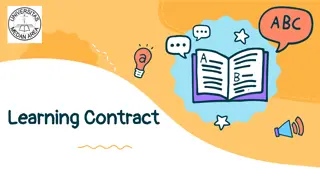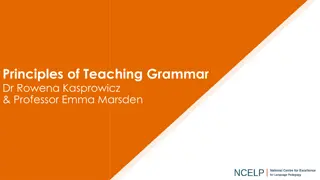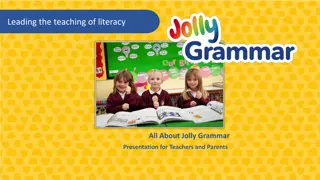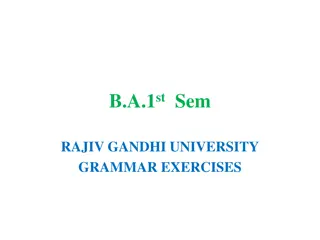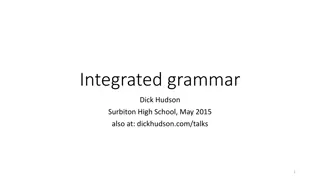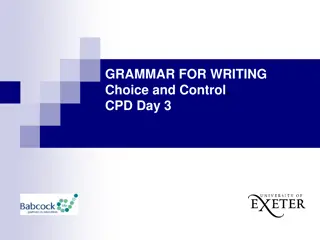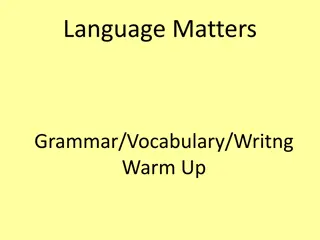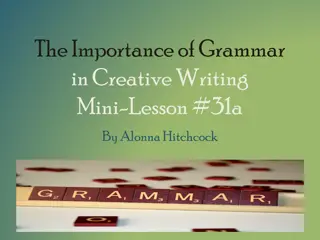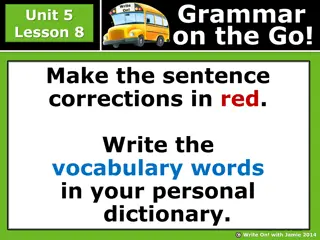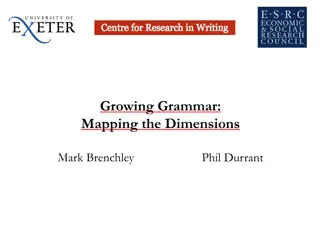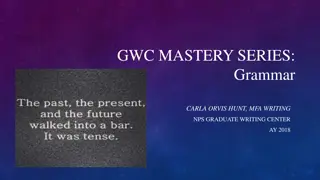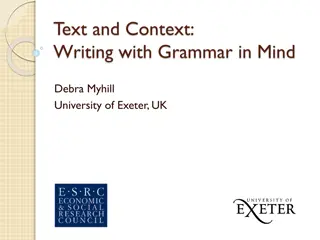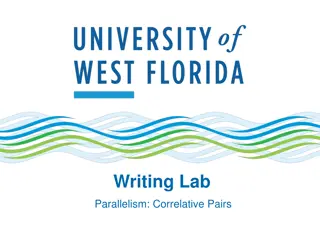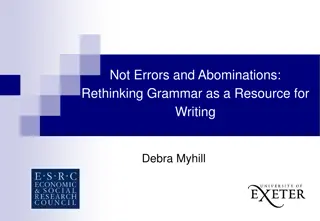Explore Grammar for Writing: Choice and Control
Delve into the CPD days dedicated to sharing the Grammar for Writing pedagogy, enhancing subject knowledge, and providing valuable support for future planning. With a focus on principles, activities, narrative fiction, argument schemes, and insightful research projects, this journey empowers educators to enrich their teaching methods and student outcomes.
Download Presentation

Please find below an Image/Link to download the presentation.
The content on the website is provided AS IS for your information and personal use only. It may not be sold, licensed, or shared on other websites without obtaining consent from the author. Download presentation by click this link. If you encounter any issues during the download, it is possible that the publisher has removed the file from their server.
E N D
Presentation Transcript
GRAMMAR FOR WRITING Choice and Control.
Now its your turn! 3 CPD days: Sharing the Grammar for Writing pedagogy Support for subject knowledge Two fully resourced schemes of work Our thoughts with the benefit of hindsight Support for future planning 4
An overview CPD day 1 The principles behind the pedagogy Subject knowledge support Activities illustrating the approach CPD day 2 Subject knowledge support Narrative Fiction Scheme of work CPD day 3 Argument Scheme of Work Sharing what we have learned Support for future planning 5
The Research Project Government funding to EEF (Education Endowment Foundation) to fund interventions to raise attainment; These interventions use a very particular research approach called a randomised controlled trial which has its own very particular rules ; The University of Exeter team led the intervention; A team from the University of York evaluated the effectiveness of the intervention; We will let you know the outcomes of the evaluation. 6
The Research Project 155 schools involved in the project; All of year 6 in each school is involved; Schools have been randomly allocated to an intervention or a comparison group; You are the comparison group! The comparison group is used so that we can measure rigorously whether any improvement in writing groups is due to the intervention or whether it is just natural progress over time. 7
A TASTE OF THINGS TO COME NOTE THAT THIS APPROACH: 1. uses authentic texts 2. is playful 3. emphasises choice not error 4. uses grammar terms with examples 8
A Classroom Example Context: creating character description Learning Focus: using proper nouns to convey information about character Grammar terms with examples Making choices Authentic texts Playful Dick Dastardly in the Mean Machine Peter Perfect in the Turbo Terrific Sergeant Blast and Private Meekly in the Army Surplus Special Create your own character and vehicle for the race, can you use proper nouns to show character? 9
An Embedded Approach The aim is not to teach grammar, the aim is to teach writing Grammar is embedded in the teaching of writing NOT SEPARATED FROM IT The aim is not to highlight and correct error, the aim is to highlight how grammar choices shape meaning The aim is to make explicit how different grammatical constructions offer the writer choice and control The aim is for young writers to understand the grammar- meaning relationship 10
GRAMMAR SUBJECT KNOWLEDGE Phrase Clause Sentence -Verb 11
Phrase, clause, sentence? Beauty and the Beast - Geraldine McCaughrean (2000) 13
Slots in a clause Subject Verb Object Adverbial Complement (adjective) / Complement (noun) Gregor ate bread greedily. Beauty s father was eating the freshly baked bread in the sumptuous palace.
Phrase, Clause or Sentence? Which is which? phrase? the noise was driving Peter crazy sentence? in the west of the city beneath their crystal skies who had lived all his life in narrow streets life was so peaceful when it rained the only house summer grew weary clause? from The Paradise Garden by Colin Thompson
Big Ideas: Phrase, clause, sentence A sentence: Has at least a subject and a verb e.g Beauty waited. The verb is finite (has person and tense). Has at least one clause but may have more (single clause sentence or multi-clause sentence). When he looked up, he was not out of doors at all. Begins with a capital letter and finishes with end punctuation .
Big Ideas: Phrase, clause, sentence A clause: Has to have a verb (finite or non-finite) and usually has a subject although this may be implied. May make grammatical sense on its own and be a single clause/simple sentence OR a main clause in a multi-clause sentence. Eg Gregor ate bread because he was hungry. May start with a subordinating conjunction eg if, because, when, although. This type of clause (subordinate) is dependent on a main clause to make complete grammatical sense eg Gregor ate bread because he was hungry.
Big Ideas: Phrase, clause, sentence A phrase: is a group of words clustered around a head word. The head word give the phase its name e.g noun phrase - his horse; adverbial phrase very warily; fills a slot in a clause e.g SVOAC; a verb phrase can fill the verb slot instead of a single word verb e.g is scoffing, has been scoffed.
VERBS 20
The Problem of the Doing Word A VERB IS A DOING WORD What is the verb in this sentence? Many verbs in authentic texts are not evidently doing words at all: the verbs to be and to have are the most frequent; Often the word which seems to evoke doing in a sentence is not the verb: I love hunting. I saw the dreamcatcher. It quickly came from nowhere 21
Getting confused We called it the garage called can t be a verb because it s not really a doing word or anything A statue quickly came out of nowhere student identifies quickly as the verb because it is a doing word he tugged open the door student identifies tugged as an adjectives because it is describing what he is doing to the door 22
Find all the Verbs Mr and Mrs Dursley, of number four, Privet Drive, were proud to say that they were perfectly normal, thank you very much. They were the last people you d expect to be involved in anything strange or mysterious, because they just didn t hold with such things. Mr Dursley was the director of a firm called Grunnings, which made drills. He was a big, beefy man with hardly any neck, although he did have a very large moustache. Mrs Dursley was thin and blonde and had nearly twice the usual amount of neck, which came in very useful as she spent so much of her time craning over garden fences, spying on the neighbours. The Dursleys had a small son called Dudley and in their opinion there was no finer boy anywhere. 23
Verbs Mr and Mrs Dursley, of number four, Privet Drive, were proud to say that they were perfectly normal, thank you very much. They were the last people you d expect to be involved in anything strange or mysterious, because they just didn t hold with such things. Mr Dursley was the director of a firm called Grunnings, which made drills. He was a big, beefy man with hardly any neck, although he did have a very large moustache. Mrs Dursley was thin and blonde and had nearly twice the usual amount of neck, which came in very useful as she spent so much of her time craning over garden fences, spying on the neighbours. The Dursleys had a small son called Dudley and in their opinion there was no finer boy anywhere. 24
Language Detectives be am are is was were being been have has had having Display posters of all the possible variations of the verbs be and have and explain they are very common verbs in English; Give out a range of authentic texts of about 200 words and ask children to underline all incidences of the verbs be and have in their texts, using the posters as a guide. Who has the most examples? Support children from an early age in simply knowing that these variations of be and have are always verbs. 25
Language Detectives: Lexical Verbs Lexical (main) verbs are the verbs teachers are referring to when they talk about a doing word; But they often don t express a lot of doing. It can be helpful to think about action verbs, reporting verbs and sensing verbs Action verbs: these verbs express an action, such as: jump, dance, eat or ache. They do also express actions which are less obviously active such as: organise, lead, or survive. Reporting verbs: these verbs tend to relate to speech and how something is said, such as: whisper, suggest, exclaim or shout. Sensing verbs: these verbs express thinking, feeling or understanding, and include verbs such as: believe, know, imagine, enjoy, fear, see or hear. 26
Teacher Knowledge It does help you in your work with children if you understand the difference between main and auxiliary verbs, including modal verbs. . I dance I am dancing I danced I was dancing I had danced I could have danced I might be dancing I should have been dancing These are all verb phrases: a verb phrase can be one verb or a string of verbs one after another I is a pronoun: not part of the verb phrase but here to help the examples make sense 27
Teacher Knowledge It does help you in your work with children if you understand the difference between main and auxiliary verbs, including modal verbs. . The main verb: this is often the doing verb. It is the main verb in the phrase and the one you d look up in a dictionary I dance I am dancing I danced I was dancing I had danced I could have danced I might be dancing I should have been dancing Look at the position of the main verb: it is either on its own or last in the verb phrase 28
Teacher Knowledge It does help you in your work with children if you understand the difference between main and auxiliary verbs, including modal verbs. . I dance I amdancing I danced I wasdancing I haddanced I could havedanced I might bedancing I should have been dancing The auxiliary verb: It helps to create shades of meaning in the verb phrase and is usually formed with variations of be or have, but sometimes with do or get 29
Teacher Knowledge It does help you in your work with children if you understand the difference between main and auxiliary verbs, including modal verbs. I dance I amdancing I danced I wasdancing I haddanced I could havedanced I might bedancing I should have been dancing The modal verb: expresses shades of possibility and certainty Modal verbs are one kind of auxiliary verb 30
Verbs: Main or Auxiliary? Mr and Mrs Dursley, of number four, Privet Drive, were proud to say that they were perfectly normal, thank you very much. They were the last people you d expect to be involved in anything strange or mysterious, because they just didn t hold with such things. Don t forget that be and have are common main verbs! Mr Dursley was the director of a firm called Grunnings, which made drills. He was a big, beefy man with hardly any neck, although he did have a very large moustache. Mrs Dursley was thin and blonde and had nearly twice the usual amount of neck, which came in very useful as she spent so much of her time craning over garden fences, spying on the neighbours. The Dursleys had a small son called Dudley and in their opinion there was no finer boy anywhere. 31
Teaching Ideas Language Detectives: the Curious Case of the Verb Phrase Select ten sentences from a book or a text you are reading together, and reproduce on a strip of paper. Put these strips into an envelope for each group, with an imaginary detective agency name label on it. Display the three different verb groups (the modal verbs; the auxiliary verbs; and a sample of lexical verbs). Recap on their understanding of these. 32
Teaching Ideas Language Detectives: the Curious Case of the Verb Phrase Ask children to underline all the verb phrases in each of the sentences, and then to see if they can work out the order in which these types of verb occur in a verb phrase. Then come together as a whole class to discuss the findings of the detectives and to see if they have found a solution. Using a whiteboard with modals, auxiliaries and lexical verbs colour-coded may act as a visual support here. 33
Verbs: A classroom example The Snow Leopard by Jackie Morris Pattern of three co-ordinated clauses back in the mountains, the young Snow Leopard looked up at the stars mirrored in her blue cat s eyes, heard the whisper and began a new song. Grammar-meaning link: Conveys narrative information concisely and emphasises the sequence of events. Verbs can carry the plot Patterns of three create good rhythm in a text. 34
Impact on writing: an example and the cat stirred, rose and leapt up to the high wild mountains with the Child clinging tight on her back. And back in the mountains, the young Snow Leopard looked up at the stars mirrored in her blue cat s eyes, heard the whisper and began a new song. The Snow Leopard Jackie Morris Golden Lion Tamarin forced the trees to form a cunning cage to protect the heart of the forest; the magical, black diamond. She wrapped the trees in loving leaves, crowded creatures onto the tropical trees and gave the plants the sun and water they needed. Year 6 able writer At first peak of light, over the ever green mountain, the bald eagle raced to create the wind, soared through the secret forest to awaken all animals and squawked over the green ocean canopy to make the mystical mist. Year 6 weak writer 35
Planning for progression: The Verb Develop children s learning of verbs in steps which help build their concept knowledge: Make sure they have secure understanding of verbs be and have and all their variations; Tell them a verb which is an action word is one kind of verb (lexical); Make sure they can see that lots of lexical verbs don t have much doing: talking about action, reporting and sensing verbs might be helpful; Develop understanding of verb phrases: both a single verb and a sequence of verbs 36
HOW GRAMMAR CREATES CHOICE 37
The Exeter Approach It is not a course in grammar; it is a way of teaching writing; It draws on many of the good practices already commonly used in the teaching of writing: drafting, revising, editing; creative stimuli for writing; peer collaboration; the scaffolding of writing tasks The attention to grammar is embedded within this and is intended to be explicit and to help writers develop understanding and independence in making choices in their writing; It constantly makes links between reading and writing; It is underpinned by a set of pedagogical principles to guide how the grammar is used; The goal is to support young writers in developing a repertoire of infinite possibilities for writing. It is research-based. 38
Teaching Writing Creatively To write well we all need to have something to say and a desire to say it; Before young writers can meaningfully attend to how they have written something, they need to have engaged with what they want to say the ideas; Engaging young writers imaginations, emotions and personal beliefs is a really important part of teaching writing; Allowing young writers freedom to explore ideas, test things out, and to write to find out what they want to say is critical We often move far too quickly to pinning things down, and making writing a very linear process we need to create space for exploration, experimentation and re-drafting. This is built into both of our Schemes of Work. 39
The Day Of Ahmeds Secret Florence Parry Heide & Judith Heide Gilliland (1997) 40
Writers Choices Choice of verb tense (present) and verb aspect (present perfect) can convey shades of meaning, such as illustrating the relationship between Ahmed and his father. 41
The next day was rainy and dark. Rain fell on the roof of the barn and dripped steadily from the eaves. Rain fell in the barnyard and ran in crooked courses down into the lane where thistles and pigweed grew. Rain spattered against Mrs Zuckerman s kitchen windows and came gushing out of the downspouts. Rain fell on the backs of the sheep as they grazed in the meadow. When the sheep tired of standing in the rain, they walked slowly up the lane and into the fold. 42
by this lake through the deep dark wood In my underground house by these rocks in my treetop house by this stream in my log pile house over his back on the end of his nose in the leaves Prepositional phrases: Usually, a preposition (in; on; under; for; by; near; beside .) plus a noun/noun phrase. 43
by this lake through the deep dark wood In my underground house by these rocks in my treetop house by this stream in my log pile house over his back on the end of his nose in the leaves Prepositional phrases: A prepositional phrase is usually composed of a preposition (in; on; under; for; by; near; beside .) plus a noun/noun phrase. 44
Creating Visual Descriptions The next day was rainy and dark. Rain fell on the roof of the barn and dripped steadily from the eaves. Rain fell in the barnyard and ran in crooked courses down into the lane where thistles and pigweed grew. Rain spattered against Mrs Zuckerman s kitchen windows and came gushing out of the downspouts. Rain fell on the backs of the sheep as they grazed in the meadow. When the sheep tired of standing in the rain, they walked slowly up the lane and into the fold. From Charlotte s Web by E.B.White 45
Creating Visual Descriptions The next day was rainy and dark. Rain fell on the roof of the barn and dripped steadily from the eaves. Rain fell in the barnyard and ran in crooked courses down into the lane where thistles and pigweed grew. Rain spattered against Mrs Zuckerman s kitchen windows and came gushing out of the downspouts. Rain fell on the backs of the sheep as they grazed in the meadow. When the sheep tired of standing in the rain, they walked slowly up the lane and into the fold. From Charlotte s Web by E.B.White 46
Writers Choices One way to create a strong visual description of a narrative scene is to use precisely-chosen prepositional phrases. 47
What might you draw attention to grammatically in this text as features of a persuasive argument? Think of a new crayon colour and what the crayon s complaint might be? Write a new letter to Duncan outlining your complaint. 48
Writers Choices There are many different things you can do to write a persuasive argument eg: Use formal language to signal your authority (Verbs: I wish to congratulate); Use informal language to build a relationship with your reader (loads; crazy); Use nouns instead of adverbials to signal structure (two reasons; one; the second reason) Make a clear statement sentence to express what you want (Please settle ) 49
GfW: Four Key Teaching Principles Make a link between the grammar being introduced and how it works in the writing being taught; eg exploring how past and present tense are used in newspaper reports for recount and comment Explain the grammar through examples, not lengthy explanations; eg exploring how prepositional phrases can establish setting in narrative through a card sort of a range of prepositional phrases from The Gruffalo . Build in high-quality discussion about grammar and its effects. eg discussing as a whole class the different grammatical choices in two students drafts of the ending to an argument piece. Use examples from authentic texts tolinks writers to the broader community of writers; eg using the class shared book as a source for exploring how grammar shapes meaning 50




